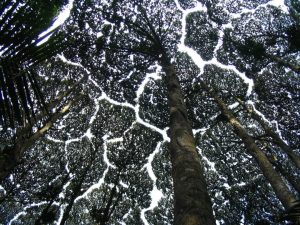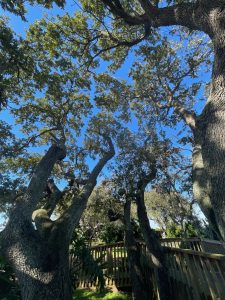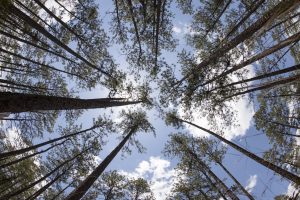
The Borneo camphor tree (Dryobalanops aromatica) exhibits a perfect example of crown shyness. Photo from Wikimedia commons at the Kuala Lumpur Research Forest
I spent a lot of time in my childhood lying in our backyard hammock, reading. Inevitably, I’d take a break and stare up at the tree canopy above me. We had sweetgum trees in that corner of our yard, and I’d watch squirrels chasing each other through the branches. One thing I noticed, but never really investigated, was how the highest branches spread out towards each other from the clump of trees, yet didn’t touch or overlap each other. You could nearly always see gaps of sunlight outlining the individual trees.

The canopy of mature oak trees exhibiting crown shyness. Photo credit: Carrie Stevenson, UF IFAS Extension
The term for this is “crown shyness.” As anthropomorphized as that seems, it’s an apt description for this seemingly polite growth pattern. The topmost branches of any given tree are in constant competition with each other for sunlight. Being photosynthesizers, sunlight is life. No growth can happen without the basic ingredients of sunlight, water, and carbon dioxide. So, from a tree’s perspective, there is an inherent disincentive to send growth beneath their own existing branches or those of an adjacent tree. The result of this is a botanical dance of sending branches out, neighboring trees doing the same, and multiple trees subtly angling for light. It’s like sharing an armrest on an airplane with a stranger. There’s a limited and highly desirable resource (the armrest), resulting in a (hopefully) gentle back and forth where someone either claims the space fully or you make an unspoken agreement to share it. If you do share it, it’s rare your arms touch; most of us want to keep some personal space!

Like Blue Angel jets in the diamond formation, trees will keep just a bit of sunlight between them and their neighbor. Photographed by Mass Communication Specialist 1st Class Ian Cotter. Official U.S. Navy Photograph.
While we may consciously shuffle for position in crowded public spaces, this happens for trees at a metabolic level. Evidence from an Argentinian study demonstrated that trees can “detect the presence of neighbors before being shaded by them,” using an internal sensor that detects light on the red:far red spectrum. This botanical spidey-sense comes from light-receptor proteins called phytochromes, which send out an alert that they’re close to another tree and may want to stop sending branches that direction. Growing into an adjacent tree quickly brings diminishing returns for absorbing sunlight, and it is in the tree’s best interest to keep a safe distance.
Crown shyness appears to be more pronounced in groves of same-species trees. Monocultures like pine plantations, or even large stands of black mangrove, exhibit the same growth patterns and timing, adapting to environmental factors the same way—particularly if they were planted or germinated at the same time. Foresters or ecologists trying to maximize the space for timber, fruit, or ecosystem restoration may want to deliberately encourage a diverse array of species, which fill in the gaps beneath the canopy and survive on less direct sunlight.

Maybe we could call it “crowd” shyness when people step back to give folks room to dance, avoiding “mechanical abrasion”! Photo credit: Cole Stevenson, University of the South
Another contributing factor to crown shyness, and perhaps one of the more crucial ones, is “mechanical abrasion.” University of Florida botanist Francis “Jack” Putz conducted research on this in Costa Rica back in the 80’s, which is still frequently cited in more recent publications. His team’s findings showed that crown shyness was “positively correlated with the distance pairs of trees adjacent to the gap swayed in the wind.” When tree branches physically bumped into one another on a regular basis, they kept their distance to prevent bud, bloom, and branch tip damage. For this scenario, imagine someone dancing enthusiastically in the middle of a big music festival—if there’s room, people will often spread out. The more the person flails, the more space you give them. If they’re just minimally swaying back and forth, you might stand closer. Putz, et. al observed this same principle in the coastal mangrove forests—more flexible branches adjacent to one another gave each other more space, while those with “stiff crowns” that couldn’t move much grew closer together.
When space opens up due to the loss of a neighboring tree or branch, the infusion of sunlight/fuel spurs a tree to send energy quickly to gain the advantage over adjacent trees. Tree species vary in their capability and success in doing this. An earlier article on pioneer species (the first to occupy a newly open space) and the process of succession sheds more light on this natural phenomenon. In a mature forest, the end result is a balanced mosaic of tree branches reaching out and nearly touching one another, but leaving each other space to grow.
- Yucca–A Tough and Versatile Native Plant - November 26, 2025
- Blazing Star - November 6, 2025
- University of West Florida’s New Heritage Roots Garden - October 17, 2025

